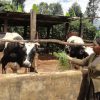How Smart Investments in Technology Can Beef up Africa’s Economy

KAMPALA, Jul 24 (IPS) - There is no shortage of technological innovations designed to boost animal agriculture in Africa. These range from GPS tracking systems which identify and trace pastoralists' herds to livestock vaccine SMS services that alert farmers to disease outbreaks.
But to unlock the economic potential of the sector as demand for meat and milk swells threefold towards 2050, countries must invest in the critical areas that will improve quality across the whole value chain. That is increasing productivity and quality from the breeding of the animal throughout the production process to the end product. This includes safe storage, handling and sale.
My native Uganda offers some useful lessons from its use of smart investments in technology and farmer organisation. These have made it the only East African country that is self-sufficient in milk.
In recent years, some private sector players in Uganda have invested in testing systems to detect aflatoxin in animal feeds. The goal is to prevent milk and meat contamination. Others have developed refrigeration units that are powered with biogas from manure. Both are among the innovations that improve the quality of the final product.
As highlighted by a new report from the Malabo Montpellier Panel on which I sit, the same can be achieved elsewhere. It can also benefit other livestock commodities, to give Africa food sovereignty across animal-sourced foods and greater access to international markets.
The report makes 11 recommendations for Africa's livestock sector. These range from technological innovations and supportive policies to addressing trade barriers and challenges specific to each commodity.
Priority areas
African nations must be strategic in prioritising the infrastructure that will make the most difference to quality and productivity. The first priority is to increase consumer awareness around food safety, nutrition and sustainability to kickstart demand for better quality products.
Partly as a response to European consumer expectations around quality and safety, for example, Morocco developed a new system for animal identification and traceability in 2015.
Livestock can be identified using electronic tags that communicate with the national database via mobile phone networks. This increases transparency and traceability. It also promotes Moroccan animal products on international markets such as the European Union.
The second priority is then to direct technology towards opportunities to open up market access.
To unlock trade means investing in improved animal health, processing operations, storage and distribution. Meeting regional and international standards for food safety and quality is a vital goal. Africa currently contributes 2.8% of the global meat market, which translates to 14 million tons. The continent produces just over 10% of the world's milk.
There are a number of barriers to increasing this production and gaining greater market share. They include limited availability of quality animal feed, access to affordable energy needed in producing and processing livestock, and limited infrastructure, particularly in the last mile.
With meat and milk being perishable goods, innovation in the cold chain and sustainable energy supplies will help strengthen the sector.
For example, an East African initiative which centralised milk quality testing and storage in chillers prior to sale increased yields sixfold within five years.
The volume of milk supplied to the 30km catchment area rose to three million litres a month. This increased income per smallholder household by more than 160% in Uganda, 120% in Kenya, and almost 65% in Rwanda.
The success of such projects in turn drives demand for continued innovation, such as solar-powered cold chains or interventions that protect other resources like water and grasslands.
Finally, countries also need to prioritise policies that support new technologies across the livestock sector.
To transform its milk production sector, Uganda privatised the state-owned processing company Dairy Corporation as well as creating a Dairy Development Authority.
The Dairy Industry Act of 1998 empowered the authority to enforce milk hygiene standards and quality controls. As a result, traders were licensed to meet public health and milk quality standards. This encouraged the modernisation of the sector through the expansion of pasteurisation plants and processing infrastructure as well as processing of high value products.
Certainly, the gains have trickled down to the farmers in better farm gate prices.
Conclusion
As the Malabo Montpellier Panel points out, many of the tools needed to tap into the potential of Africa's livestock sector exist already. But with limited resources, they must be deployed smartly to improve the entire value chain.
Scaling up innovation at critical points will unlock new opportunities and help ensure animal agriculture keeps pace with a rising demand from a growing population.![]()
Noble Banadda, Professor and Chair of the Department of Agricultural and Bio Systems Engineering, Makerere University
This article is republished from The Conversation under a Creative Commons license. Read the original article.
© Inter Press Service (2020) — All Rights Reserved. Original source: Inter Press Service
 Global Issues
Global Issues